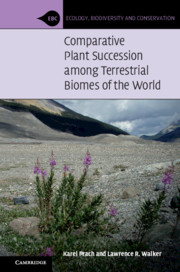Book contents
- Comparative Plant Succession among Terrestrial Biomes of the World
- Ecology, Biodiversity, and Conservation
- Comparative Plant Succession among Terrestrial Biomes of the World
- Copyright page
- Contents
- Preface
- 1 Introduction
- Part I Plant Succession and Biomes
- Part II Succession by Disturbance Type
- 4 Comparative Approach
- 5 Volcanoes
- 6 Glaciers
- 7 Cyclones
- 8 Dunes
- 9 Landslides
- 10 Floods
- 11 Fire
- 12 Clearcuts
- 13 Plowed Fields
- 14 Mines
- 15 Other Disturbances
- Part III Synthesis
- Book part
- References
- Index
10 - Floods
from Part II - Succession by Disturbance Type
Published online by Cambridge University Press: 08 May 2020
- Comparative Plant Succession among Terrestrial Biomes of the World
- Ecology, Biodiversity, and Conservation
- Comparative Plant Succession among Terrestrial Biomes of the World
- Copyright page
- Contents
- Preface
- 1 Introduction
- Part I Plant Succession and Biomes
- Part II Succession by Disturbance Type
- 4 Comparative Approach
- 5 Volcanoes
- 6 Glaciers
- 7 Cyclones
- 8 Dunes
- 9 Landslides
- 10 Floods
- 11 Fire
- 12 Clearcuts
- 13 Plowed Fields
- 14 Mines
- 15 Other Disturbances
- Part III Synthesis
- Book part
- References
- Index
Summary
A floodplain occurs where river water leaves its normal channel and deposits or removes sediments during a flood event (Plate 17). Deposited sediments can be ephemeral because they are subject to erosion from the next high-water event. Yet where floodplains provide a stable surface, plant growth and succession can occur. Substrate texture and fertility vary, much like landslides, and this variability affects succession. The interaction of substrate quality with local topography and water quality and flow create many habitats for plant growth. Floodplains represent (like landslides) an intermediate status between primary and secondary succession. At one extreme, floods can completely remove all prior vegetation and organic matter, triggering primary succession on a layer of fresh silt, sand, or gravel. At the other extreme, intact vegetation and soils can raft down a river to a new location or new silt can simply be layered on top of an existing forest floor, leaving everything intact; both of these would trigger secondary succession. Silt deposition over an existing organic soil resembles succession following volcanic ash deposition (Zobel & Antos, 2009). The spatial scale of a flood is generally positively correlated with its intensity because large floods often provide the most intense, damaging results (Hughes, 1997). Floodplains are also intermediate in their susceptibility to human influence compared to other types of disturbance. Humans have long resided on floodplains, which are fertile and flat, and they provide many services (e.g., for drinking, fishing, washing, cooking, waste disposal, and transportation). Manipulation of floodplains began early in human history (e.g., with irrigation channels for agriculture) and has culminated in vast destruction by humans who have co-opted many floodplains for industries, hydropower, and urban growth (del Moral & Walker, 2007).
- Type
- Chapter
- Information
- Publisher: Cambridge University PressPrint publication year: 2020



